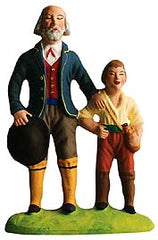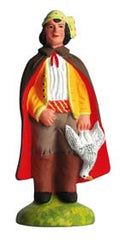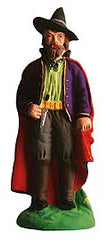Roustido - The Man with the Lantern - the Seventh (7th) "Essential" Santon for a Provençal Creche
Roustido, The Man with the Lantern – Homme à la lanterne (French) – is the seventh most favorite Santon on the list of the top 20 Santons included in the creche by the Provençal people – see our earlier post, the Essential Santons for a Provençal Creche. He is available in all four Marcel Carbonel Santons sizes offered by My Growing Traditions.
Roustido derives from Antoine Maurel’s Pastorale. In the Pastorale, he is a friend and neighbor of Margarido and her husband Mr. Jourdan. Roustido is older and hard of hearing. A former notary, he is sometimes portrayed with a hat - see Size #1 - rather than his night cap (Sizes 3, 2, and Puce). As a notary he is also associated with a red umbrella, although the Carbonel studios have not used the umbrella with any of their Roustido Santons.
He is late to hear the shepherds call. One of the few remaining in the village in the middle of the night, he uses his lantern to go to Margarido and Mr. Jourdan in order to rouse them. Once at the stable he greets the Holy Family with a doff of his cap.
Winter Solstice - December 21
The United States Forest Service has posted an article celebrating the Plants of the Winter Solstice by Larry Stritch. Stritch provides the history and symbolism of the holly tree, the yule log, the mushroom, mistletoe, and the Yule tree, and ends his discussion with information about our National Christmas Tree. It is really a delightful and most informative article. Enjoy!

Santons Prayer - Christmas Eve in Provence
The Santons Prayer quoted in the 1940s has traditionally been recited by the children of Provence as they gather around the creche after Christmas Eve supper has been celebrated. Some refer to it as the Christmas prayer of the Children of Provence.
"Little Jesus of the Crib:
Make us philosophical as the fisherman,
Carefree as the drummer,
Merry as the troubadour in exploring the world,
Eager for work as the bugler, patient as the spinner,
Kind as the ass, strong as the ox which keeps you warm.
Give us the sacred leisure of the hunter,
Give us also the desire of the shepherd for earthly things,
The pride in our work of the knife grinder and the weaver,
The song of the miller.
Grant us the knowledge of the Magi, the cheerfulness of the pigeon,
The impulsiveness of the cock, the discretion of the snail,
The meekness of the lamb. Give us the goodness of bread,
The tenderness of the wild boar, the salt of the haddock,
The good humor of old wine, the ardor of the candle,
The purity of the star.
Make us equal, dear Jesus, to our ancestors who honored you with their Christmas cribs.
Let us continue this custom while they watch over us in a Heaven which must resemble our Cribs with the Good Mother, the Infant Jesus, the angels, and these santons who are so kind they never speak an ill word of any person.
Pray, Lord, for our ancestors who passed down the Crib, for our mothers who taught us its art, for our fathers, for our homes.
We pray at your feet, Good Jesus, who wished to be born among the lowly people of this earth.
Pray for our native land, for the peace of its firesides, and for the future of our people.
Lord, pray for Provence! And upon the sea of this world, guard it as the land of your affections!"
- Foley, Little Saints of Christmas, pp. 36-37
From what Foley says, it would appear that this traditional prayer was commonly customized to include all the Santons figures in each individual family creche.
We also found this shorter version, simply cited as an Old French prayer from Provence:
"Little Jesus of the crib. Give us the virtues of those that surround you. Make us philosophical as the fisherman. Carefree as the drummer. Merry as exploring the world as the troubadour. Eager for work as the bugler. Kind as the ass. Strong as the ox that keeps you warm."
New Carbonel Santon for 2012 - The Olive Gatherer - La Ceuilleuse d'olives
Every year the Marcel Carbonel Santons workshop in Marseille creates at least one new Santon, sometimes more. 2012 brings: The Olive Gatherer - La Ceuilleuse d'olives in Size #2 - the Elite size.
We always look forward to each new figure, but this year we were, to be honest, particularly pleased with the Olive Gatherer. We imagine our delight is on several different levels. She is more than elegant, wearing a wide-brimmed black hat to shade herself from the sun over a green cotton headdress. She has a headscarf on her shoulders, a pinafore around her waist, and carries a basket of olives on her left arm, a branch of olives in that left hand, and an olive rake in the other. Another container of olives lies at her feet. The painting of her costume is, as always, exquisite.
Yet, more than that, I think she is especially appealing to those of us who are not from the French culture, as she symbolizes the harvesting of the glorious olive trees and in turn the pressing of those olives into olive oil, that we, as foreigners automatically and rather romantically associate with Provence. Provence is known not for the quantity of its olive oils, but for their superb quality.

You may enjoy reading the books and website of Carol Drinkwater, of All Creatures Great and Small, who has "retired" to an olive farm in Provence and has written of all things olives. Her story is charming, as is Carbonel's new figure. It is hard to imagine someone not wanting to add The Olive Gatherer to their Santons collection.
Bringing Home the Christmas Tree - Traveling Tree
According to Lancaster (Pennsylvania) Online, the first documentation of a Christmas tree in the United States is found in a diary account of Matthew Zahm of Lancaster in 1821. An entry in Zahm's diary indicates he cut down an evergreen on December 20, 1821 "on the hill at Kendrick's saw mill" to use as a Christmas tree.
One of our favorite ornaments from Inge-Glas of Germany is Traveling Tree:
Even more fun, this year My Growing Traditions has been creating a board on Pinterest of Christmas Traditions. There, over and over again, we have found and pinned photographs of various renditions of "Bringing the Tree Home," including a photograph of the proverbial vintage red 1941 Ford pickup with a Christmas wreath on the grill and a tree in the back. Scroll down the board and you will find many different versions on a theme that is such an important Christmas tradition for many of us.
The Blind Man and His Son - the No. #3 "Essential" Santon for a Provençal creche
In March 2012 we published Essential Santons for a Provençal Creche - a list of the top 20 Santons included in the creche by the Provençal people. The Blind Man and his Son - l'Aveugle et son fils (French) – L'avugle e soun fieu (Provençal) was the third most important Santon to be included in the Provençal creche and is available in all four Marcel Carbonel Santons sizes offered by My Growing Traditions.
The Santon of the Blind Man and his Son was derived from the seemingly hopeless tale of these two central figures in the Pastorale of Antoine Maurel.
Pastorales are Provençal Christmas tales that tell the story of the birth of Christ. They are presented each year by Provençal villagers and are a part of the oral history passed down from generation to generation on Christmas Eve. The Provençal nativity uniquely consists of the biblical characters in traditional biblical dress with typical Provençal village characters, in 19th century dress, who have come to the manger to celebrate Jesus' birth. Written in 1844, Maurel's Pastorale is the most famous of the pastorales and was first performed at the Cercle d'Ouvriers - Catholic Circle of Workers (to which Maurel was a member ) in Marseille.
Having lost his sight years before in grief when an older son, Chicoulet (available in all but Size #1 [Cricket] of the four Marcel Carbonel sizes offered by My Growing Traditions),
was abducted by the Highwayman - Brigand (French) (also known as the robber and often confused with a gypsy).
The Blind Man, dressed in a spencer jacket with yellow braiding, travelled to the manger with his young son Simon (Simoun). Simoun was intent that his father should in the presence of the Saviour ask for his sight to be returned.
As Daniel J. Foley explains in his 1959 Little Saints of Christmas: The Santons of Provence:
The Blind Man "became a symbol of humility and patience. He was at the manger to thank the Good Mother for consoling the sick and afflicted. He felt that the Light of the World was within him, and even though he could not see the sky and the world about him, he knew it was beautiful because God made it so. He asked not for his sight on this earth, but that he might be granted vision when he reached the next world. He hoped that the time was not far away, for in his humble faith he believed in Paradise and the angels and, though blind, he wanted to see them." - p. 18
Being rewarded for his humble heart, his sight is returned at the manger. He discovers and is reunited with Chicoulet, and at the manger the Highwayman admits that it was he that kidnapped Chicoulet.
We now carry Wendt and Kühn Angel Orchestra Ornaments
This year we have added to our offerings Christmas ornaments from several German workshops. The Wendt and Kühn classic Orchestra Angels from Grunhainichen, Germany, in the Erzgebirge are a favorite.
We first discovered the clip-on Orchestra Angels in the 1970s in a wooden basket sitting on the floor in front of the check-out counter at a Crate and Barrel. There in that basket they lay in a bit of a heap, one atop the other. My first impression was how undignified for such exquisite, classic Angels created in Germany. Each one of them was distinctly a work of art. Yet, this was during the period of the Soviet Union, and they were made, of course, in East Germany. At that time, the workshops of the Erzgebirge were still allowed to create their traditional items, but individual ownership was quashed under the auspices of the equivalent of collectives. Interestingly, we spoke with a customer recently who had also found the Erzgebirge hand-shaved trees (Spanbaum) in a basket on the floor of Crate and Barrel. At least Crate and Barrel kept us supplied. Now we stock both the trees and 15 of the most classic clip-on Angel orchestra instruments:
To see all 15, click here: Wendt and Kuehn Orchestra Clip-On Angels.
They make a special addition to anyone's tree, especially to commemorate a member of your household who enjoys playing a musical instrument.



























